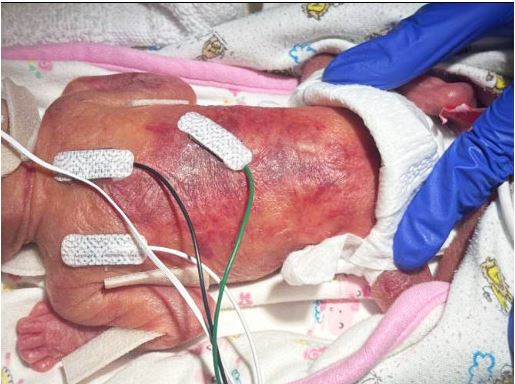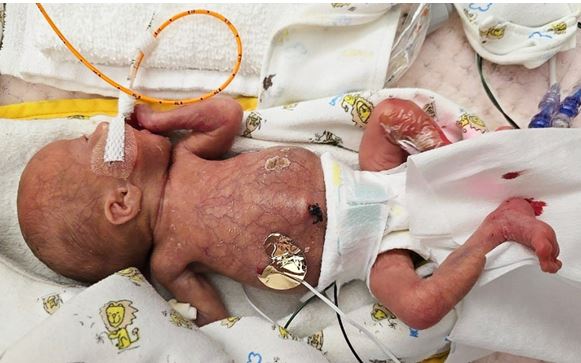Neonatal General 3: NICU Practices
Session: Neonatal General 3: NICU Practices
555 - Strategies to Facilitate Skin Barrier Maturation in the Periviable Infant
Friday, April 25, 2025
5:30pm - 7:45pm HST
Publication Number: 555.6973
Melissa Nurre, University of Cincinnati Medical Center- UC Health, cincinnati, OH, United States; Alicia Friedman, University of Cincinnati Medical Center, Cincinnati, OH, United States; Marty O. Visscher, University of Cincinnati, Cincinnati, OH, United States; Vivek Narendran, Cincinnati Children's Hospital Medical Center, Cincinnati, OH, United States

Melissa Nurre, MSN, NNP-BC
Neonatal Nurse Practitioner
University of Cincinnati Medical Center- UC Health
cincinnati, Ohio, United States
Presenting Author(s)
Background: Periviable babies depend upon robust innate immunity from the immature epidermal barrier to adapt to the microbial-laden, hostile conditions after birth. Immature skin barrier makes them susceptible to injury, inflammation, infection, and fluid/electrolyte disturbances. Dermal collagen deficiencies increase the vulnerability to mechanical forces, e.g., friction, sheer and pressure. Skin barrier after birth, rapidly adapts, upregulates cornification, produces antimicrobial proteins and small molecules to develop the acid mantle and effective skin microbiome.
Periviable babies have an extremely high transepidermal water loss (TEWL) due to significantly fewer stratum corneum layers. To manage fluid/electrolyte balance, they are placed in high humidity conditions, around 70-95% relative humidity (RH), to reduce TEWL. Consequently, the skin surface is markedly wet (higher surface hydration) increasing risks for friction injuries, maceration, higher permeability to irritants, and unfavorable microbiome development. Skin maturation is challenged by high RH, which disrupts the dryness and xeric stress needed to promote cornification.
Objective: We hypothesized that skin hydration management with non-adherent silicone foam dressings would promote cornification in periviable babies in high RH incubators.
Design/Methods: We present twin babies 22+3 weeks gestation, one delivered vaginally and the other by C-section, admitted to the NICU and immediately placed in an incubator at 70% RH. Babies were supine on an absorbent cotton blanket, with monitor leads placed on the back, head in midline position as part of IVH prevention (Figure 1). Umbilical lines were inserted with an antiseptic solution (povidone iodine) applied only to the cord stump, then sutured and secured with a soft, non-adherent cloth to avoid contact with the abdominal skin & minimize injury. (Figure 2). Areas of skin wetness, e.g., neck folds, axilla, elbows, ears, flexural and high friction were covered with a flexible, low adherent silicone foam dressing to wick away surface moisture. Dressings were lifted at 6-hour cares, checked for residual skin moisture and replaced until the skin was visibly dry.
Results: Cornification was noted by day 5 despite high incubator RH. Humidity was lowered to 35-50% by day 12 and silicone dressings were discontinued (Figure 3). Cornification progressed as evidenced by large areas of dry scaly skin suggestive of continued skin barrier maturation.
Conclusion(s): Simple strategies of minimizing skin surface wetness and avoidance of adhesive/antisepsis related skin injury promoted skin maturation in high RH.
Figure 1-
 Figure 1- shows a 22+3 week baby on day of life 5 with leads placed on the back where the skin is less hydrated from exposure to high RH. The moisture wicking, low adherent silicone foam dressing are visible in elbow crease and axilla. The darkened areas over the back, under the skin surface, could be related to bruising during C-section delivery and/or pressure injury.
Figure 1- shows a 22+3 week baby on day of life 5 with leads placed on the back where the skin is less hydrated from exposure to high RH. The moisture wicking, low adherent silicone foam dressing are visible in elbow crease and axilla. The darkened areas over the back, under the skin surface, could be related to bruising during C-section delivery and/or pressure injury.Figure 2 a,b-
.jpg) Figure 2 a, b- shows the 22+3 week baby on day of life 5. In panel a, the moisture wicking foam dressing is visible between the ear and the scalp. The injury on the lower abdomen, is likely caused by diaper contact and friction. Panel b shows the moisture wicking dressing behind the ear, on the neck, at the axilla. Note that the UVC/UVA have been sutured to the cord and the line covered in soft non-adherent dressing to avoid contact with the skin.
Figure 2 a, b- shows the 22+3 week baby on day of life 5. In panel a, the moisture wicking foam dressing is visible between the ear and the scalp. The injury on the lower abdomen, is likely caused by diaper contact and friction. Panel b shows the moisture wicking dressing behind the ear, on the neck, at the axilla. Note that the UVC/UVA have been sutured to the cord and the line covered in soft non-adherent dressing to avoid contact with the skin. Figure 3-
 Figure 3- shows the 22+3 week baby on day of life 18. The umbilical cord dried and detached on day ~10. A PICC line was in inserted on day 10. The skin surface is dry, with visible scales on the abdomen, upper chest, shoulder, face, and foot, indicative of cornification and barrier formation. The neck folds are no longer moist. The skin is more opaque than in the earlier images but the vasculature is still readily visible.
Figure 3- shows the 22+3 week baby on day of life 18. The umbilical cord dried and detached on day ~10. A PICC line was in inserted on day 10. The skin surface is dry, with visible scales on the abdomen, upper chest, shoulder, face, and foot, indicative of cornification and barrier formation. The neck folds are no longer moist. The skin is more opaque than in the earlier images but the vasculature is still readily visible. 
